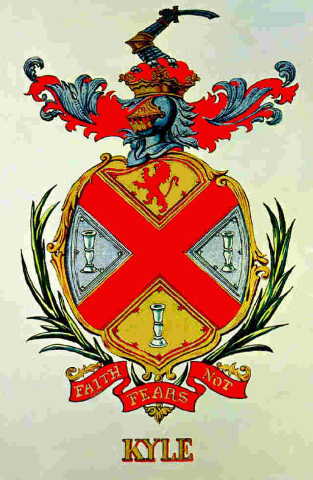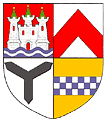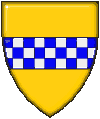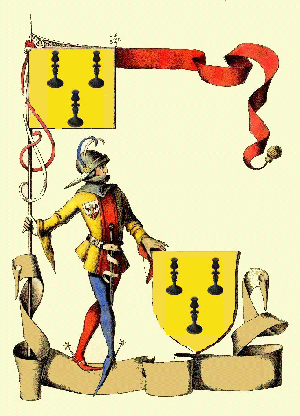
Kyle, from Nisbet 1722
Heraldry
From the most ancient times men have identified themselves with standards:
"Everyman of the
children of
-Numbers 2, verses 2 and 34.
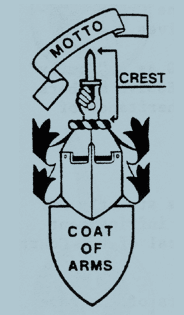 that a person has the right to use the family or clan Arms. This is
completely incorrect.
that a person has the right to use the family or clan Arms. This is
completely incorrect.A Coat of Arms belongs only to one individual person [or corporation] and can only be used by that person and no one else. In order for a person to be able to use a Coat of Arms it is necessary for that individual person to apply for a personal Coat of Arms to be granted to him or her .
What is permitted is for a member of a clan to use the clan crest . Usually what is referred to as the clan Coat of Arms is in fact the personal Arms of the chief of the clan which can only be used by the chief. -- Lord Lyon, King of Arms
See "The Right to Arms" Society of Genealogists Information Leaflet No. 15
In the case of the Kyles of Scotland/Ireland, one finds a variety of
charges displayed,
but one feature is common to all: a candlestick or candle. The number
of candlesticks or candles varies across the years and countries (The "Kyl" family in Sweden and the Danish "Kylle"
family have other features namely horns and swords respectively). According
to the eminent heraldic artist Mr. Roland Symons, also an officer of the
White Lion Society, the candlesticks are a symbol relatively unique to the Kyles.
There is one record of candles in the Arms of an "Emerle," and one
for a "Torrens," and the
candles are used for the arms of the Worshipful Companies of Founders and
Wax Chandlers. Otherwise, in Great Britain, they appear to be only used by Kyles.
The candle or candlestick is used in a number of arms on the Continent - a
few are listed here.
We find a “Kyle of that Ilk” in the Workmans Manuscript of 1565 with three gold candlesticks against a black shield (no crest or motto recorded). Under the entry it says "Kyle's coat these are candelstyks or Kylles." Also in 1565, in Slains Armorial a Kyle achievement is recorded as three gold candlesticks against a red field. Another early coat-of-arms (circa 1542) of the Kyle family is that shown in Lyndsay’s Armorial. The illustration features a black shield on which are set three tall altar candles in low candlesticks, color gold (see illustration on Homepage).
Another example is “Sir William Emmet Kyle (sometimes spelled Kile in the
records) who was born in the Craig of Kyle – a mountain town – in
-- “ Notable Southern Families, Volume V, pg 57”
Mabel Louise Keech, in Hobbies Magazine, 1946, asserts that the word
“kylle” in olden
Interestingly a coin showing the three candlesticks and dated 1649 was found in the remains of the John Dickinson Old Bailey building in London after it was bombed during the Second World War. On the back of the coin there was reference to the Old Bailey indicating that the coin had probably been on that site for almost 300 years. John Dickinson Co., stationers, currently produces a stationary with a watermark of three candlesticks (with lit candles in them) based on the coin.
Some recent writers have raised the possibility that the early Kyle Arms were not candles but rather were a type of bowling pins called "Kyles" or "Kayles" and that only later did Kyles interpret the arms as candles. You can decide for yourself. The illustration from the actual manuscript in question is shown below and labeled "Kyle, Lindsay Armorial, Adv. MS. 31.4.3, f. 109r." Apologies, that is the clearest I could get the image to display.
A more recent (probably late 1700's) coat-of-arms is below: the three Kyle candlesticks, a red Scotts lion, a red cross for Ireland, plus a coronet set atop a silver helmet, with a silver arm in armor with the hand holding a scimitar type of dagger. Below the shield flies a ribbon with the motto, Faith Fears Not (In other Kyle arms, the motto is recorded in Latin: Fides Non Timet). The shield is surrounded by a wreath which might be rosemary.
Juliet : "That's rosemary, it's for remembrance" -- Shakespeare
Illustration from "A Partial History of the Kyle, Kile, Coyle Family In America"
On the back of the original painting of these arms is written the following:
" This Kyle armorial Ensign was brought to America by Jeremiah Kyle in 1807, and bequeathed to his grandson Jeremiah Kyle Montague of Christianburg, Montgomery County, Virginia, in 1867. Jeremiah Kyle was born at Brackey Mills, County Tyrone, Ireland, October 1791, and died in Christianburg, Va., December 5, 1867. He often told his grandson that the ensign (not this particular painting) was more than eight hundred years old. Ayrshire, Scotland, was the early home of the Kyles. There they lived probably centuries prior to the reign of Oliver Cromwell. The Presbyterians of Scotland supported Cromwell and for reward were given land in Northern Ireland. It was at this time northern Ireland that two Kyles, soldiers of Cromwell, went into northern Ireland and settled there. Some of their descendants came to America (Penna) in 1720."
Kyle Mottos
Older:
Fides Non Timet.......................................................Faith Fears Not
Providentia Me
Committo......................................I Commit Myself to
More Recent:
Tibi Soli....................................................................To Thee Alone ( "To thee alone have I sinned" Psalms 51:4 )
Caelitus Vires..........................................................Strength From Heaven
(Members: Go to the members message board and click "polls" to vote for your favorite Motto.)
Candles appear in the Arms of the German Hein family which also might trace their name back to Old King Cole (aka Cole Hen):
Hein Arms
. 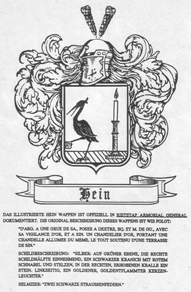
Kyles: If you would like advice to help you design your own Arms you can start HERE
Members, please help us design the coat of arms for the Kyle Family Society -- for draft Arms click HERE, for draft Crests click HERE
If you have Arms already and have a digital copy, pls email them to Kylesociety@hotmail.com so we can post them here!
Unidentified. Possibly the third son of Kyle of that Ilk recorded 1565
![]()
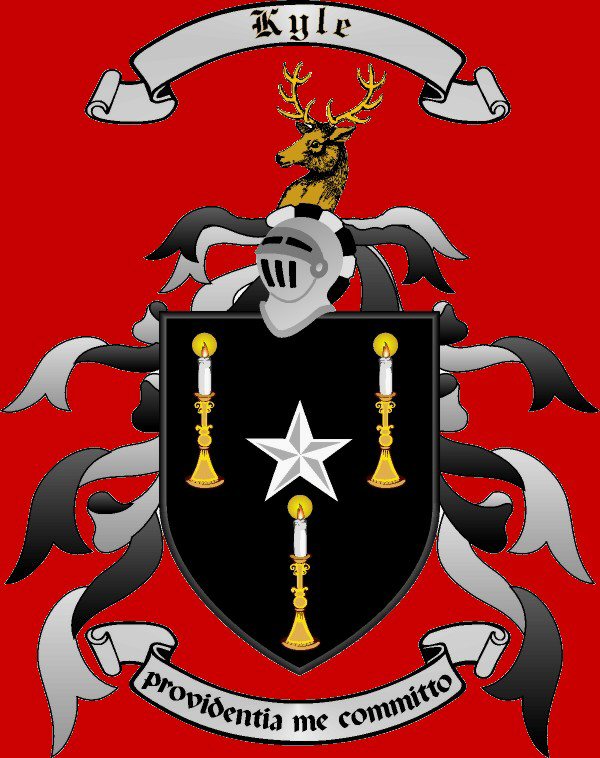
M. H. Kyle
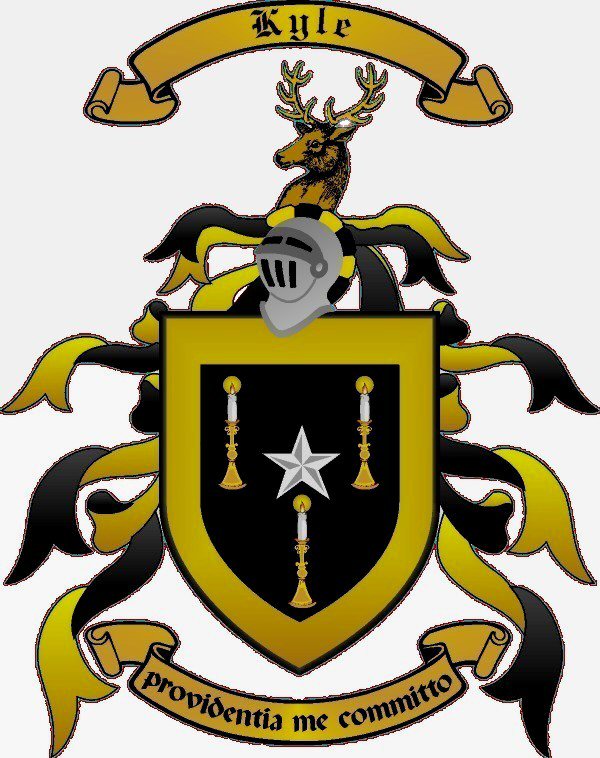
G. M. Kyle
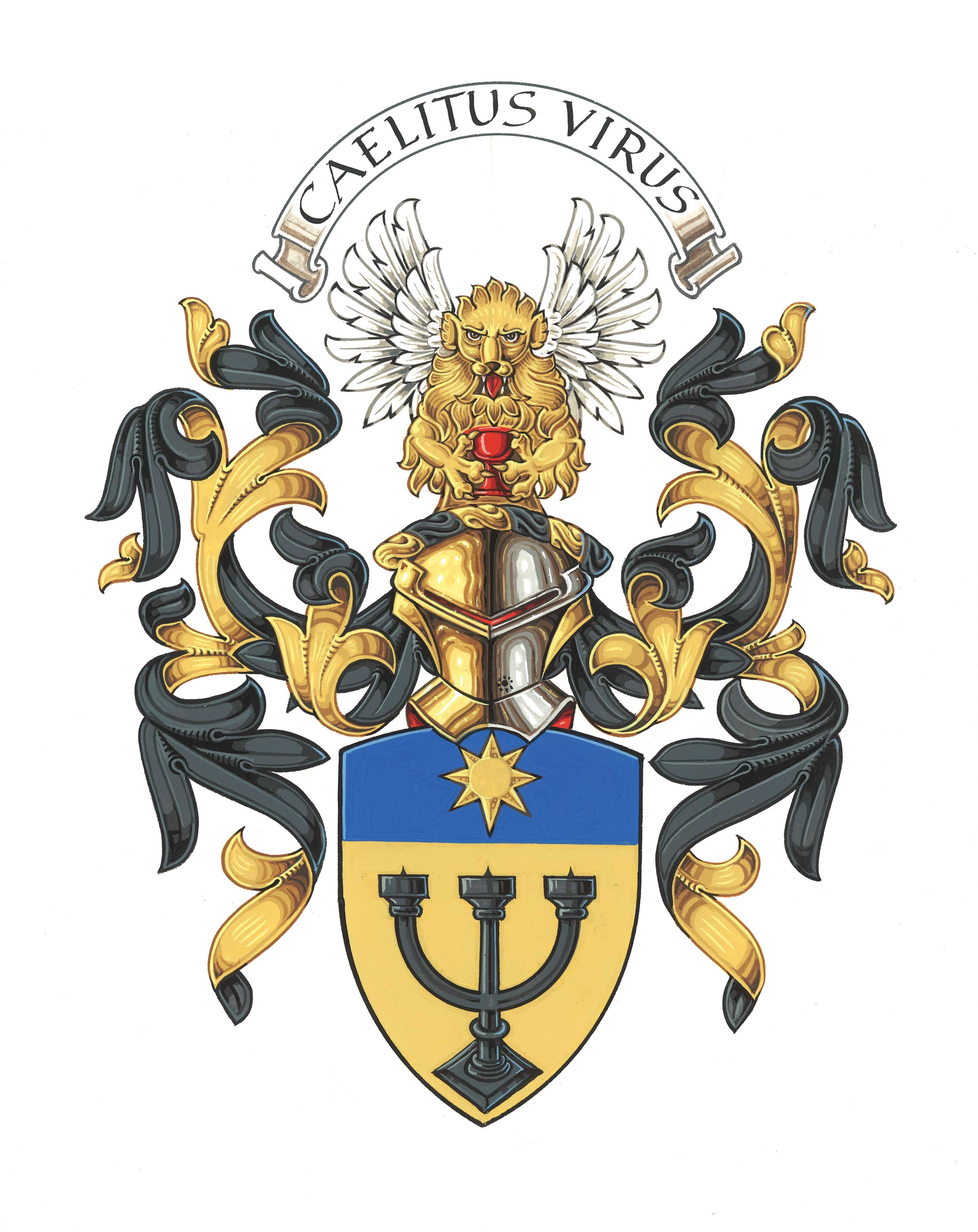
Jaeame I. Koyil
Brenda Coyle
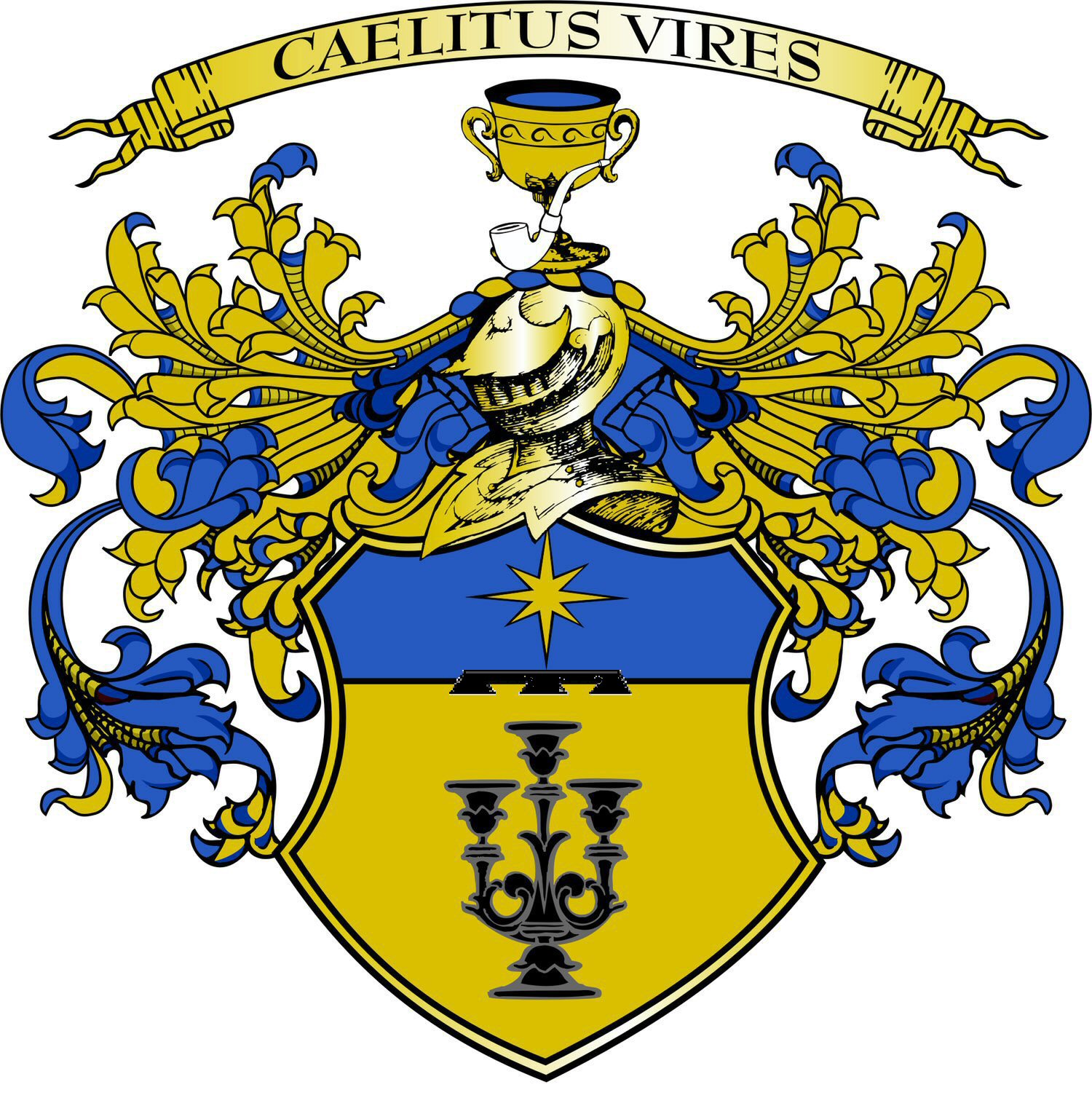
Josiah J. K. Kyle
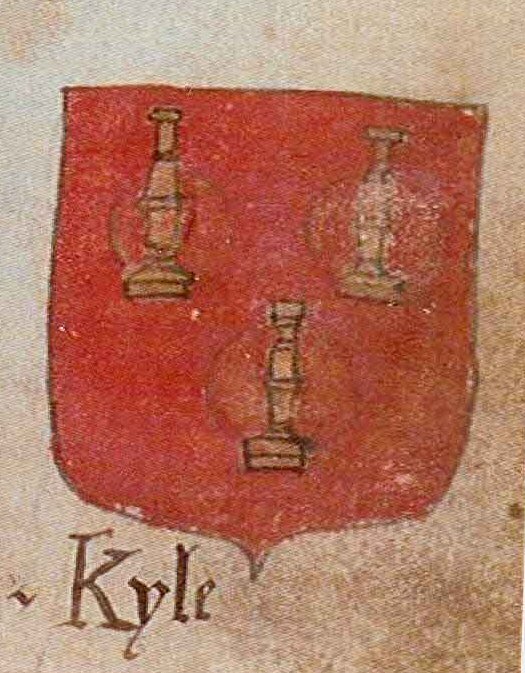
Kyle from Slains Roll 1565, page 173
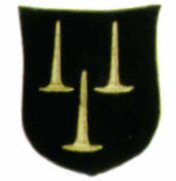
Kyle from Lindsay Armorial, Adv. MS. 31.4.3, f. 109r
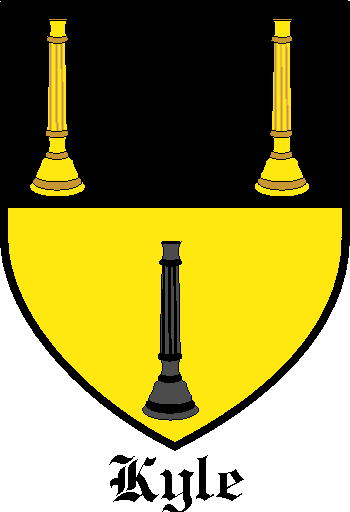
Samuel Moore Kyle, Bishop of Cork and Ross
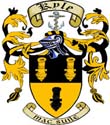
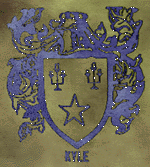
![]()
![]()

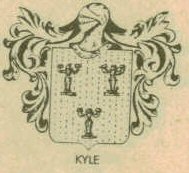
District of Kyle
The arms of the District of Kyle is marked by a checkered pattern of blue
and silver squares against a gold background. These arms are taken from a
seal of Alan, High Steward of Scotland (1177-1204), and it is shown on a
charter dated at
|
|
|
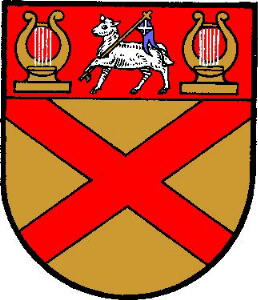
Ayrshire was
originally granted arms in 1890 (above).
These showed a red cross and in a chief on gold, the arms of Bruce, Lord of
Annandale. To these were added a paschal lamb from the arms of Ayr, and two
lyres for the musical and artistic heritage of the County.
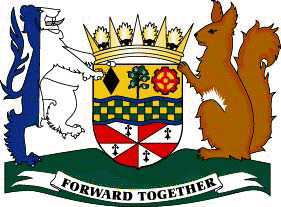
East Ayrshire Arms
The coat of arms features most of the elements from the Kilmarnock and
Loudoun arms and the Cumnock and Doon Valley arms. New additions include; an
engineering symbol, signifying the area's rich engineering past, a new motto
'forward together' as well as the addition of supporters to the shield.
The shield consists of a coronet of garbs of corn and peaks. The shield is
then divided into three sections, the top section contains elements
representing coal and a fir tree (both of which are derived from the Cumnock
and Doon Valley ams) and an engineering cog. The middle section has been
lifted from the arms of the Boyds family of Kilmarnock but is bordered at
the top and the bottom with a wavy blue line signifying East Ayrshire's two
river valleys (Irvine Valley and Doon Valley). The bottom third of the
shield is derived from the arms of the the Campbell family of Loudoun. The
supporters are the Red Squirrel from the original Kilmarnock arms and a lion
from the Cumnock arms. The lion is painted in two colors in keeping with
the original coloring .
North Ayrshire Arms
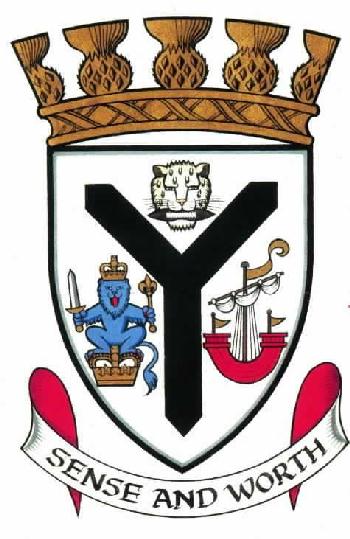
South Ayrshire Arms
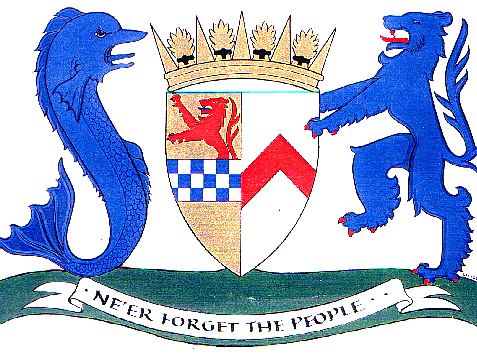
Continental Arms Using the Candle or Candlestick.
Source Rietstap Armorial
Agnelli
Parti: au 1, de gueules, au lion d'argent, tenant de ses pattes une
chandelle fumante; au 2, de sable, au chien assis d'or, les pattes levées.
Au chef de l'écu d'azur, brochant sur le parti et chargé de trois étoiles
d'or. Casque couronné.
Ardia (d')
D'azur, au chien braque courant sur une terrasse herbeuse, tenant dans sa
gueule une chandelle allumée et contournée, le chien surmonté de trois
flammes rangées en fasce, le tout au naturel. (Alias: Parti: au I d'Ardia;
au II de Palomba qui est: d'argent, à une colombe tenant un rameau d'olivier,
posée sur la cime d'un mont de trois coupeaux, le tout au naturel, au chef
d'azur, chargé de trois étoiles d'or).
Barner
D'azur, à un senestrochère, armé au naturel, la main gantée d'or tenant une
chandelle allumée du même.
Bernales
De gueules, à une chandelle d'argent ayant des gouttes à senestre, allumée
de gueules.
Brenner
De sinople, chapé-ployé d'argent, le sinople chargé d'un homme issant, posé
de front., mouvant de la pointe, habillé d'or, ceint de gueules, coiffé d'un
chapeau pointu de sable, tenant de sa main dextre une chandelle d'argent,
allumée de gueules, le senestre appuyée sur sa hanche, l'argent chargé de
deux demi-aigles de sable, becquées et membrées d'or, mouvant des flancs de
l'écu. Casque couronné.
Brenner de Felsach
De gueules, au sautoir diminué d'argent. Sur le tout un écusson agrandi, en
sorte que le grand écu ne se montre que sous forme de bordure, ledit écusson
coupé: au 1, de sinople, chapé-ployé d'argent, le sinople chargé d'un homme
issant, posé de front, mouvant de la pointe, habillé d'or, ceint de gueules,
coiffé d'un chapeau pointu de sable, tenant de sa main dextre une chandelle
d'argent, allumée de gueules, la senestre appuyée sur sa hanche, l'argent
chargé de deux demi-aigles de sable, becquées et membrées d'or, mouvant des
flancs de l'écu (Brenner); au 2, d'azur, à un rocher escarpé au naturel,
posé sur une terrasse de sinople, et un ruisseau au naturel qui découle
dudit rocher à mi-hauteur vers dextre (Felsach). Trois casques couronnés.
Brenner de Lindenberg
D'argent, à un homme issant, habillé d'azur, ceint de gueules, coiffé d'un
bonnet albanais d'azur, tenant de sa main dextre une chandelle allumée, le
champ chapé-ployé d'or, à deux demi-aigles de sable, couronnées d'or,
mouvant du chapé. Casque couronné.
Chandelon dit Bresseux
Parti: au 1, de gueules, au lion d'argent, armé et lampassé du champ, tenant
de ses pattes une chandelle du second; au 2, d'argent, à la fasce d'azur,
accompagné de trois merlettes de sable.
Churlandt
Écartelé: aux 1 et 4, d'or, au lion de gueules, tenant de ses pattes une
chandelle, celui du 1 contourné; aux 2 et 3, d'argent, au griffon de gueules,
tenant de ses pattes une chandelle, celui du 3 contourné. Sur le tout d'or à
l'aigle de sable, couronnée d'or. Deux casques couronnés.
Consoni
Parti: au 1, de gueules, au lion d'or, tenant de ses pattes une chandelle
allumée dans un chandelier d'argent; au 2, coupé: a. d'azur à la barre d'or,
accompagné de deux têtes de More; b. palé d'or et de gueules, de quatre
pièces. Casque couronné.
Cramer
Écartelé: au 1, de gueules, à un jeune homme issant, tourné vers senestre,
habillé d'une cotte d'armes d'or, rebrassé d'azur, coiffé d'un casque
d'acier et tenant de sa main dextre une corne d'abondance d'argent, trois
fois environnée d'un ruban de sinople, de laquelle sort un bouquet de roses
de gueules, tigées et feuillées de sinople, et de sa senestre une chandelle
allumée; aux 2 et 3, d'azur, à une ancre d'argent sans trabe ni anneau, la
strangue terminée en trèfle; au 4, comme au 1, la figure tournée vers dextre
et tenant la corne d'abondance de sa main senestre et la chandelle de sa
dextre. Sur le tout d'or au lion naissant de gueules, couronné du champ,
mouvant du canton senestre de la pointe. Deux casques couronnés.
Curland
Écartelé: aux 1 et 4, d'or, au lion de pourpre, couronné d'or, tenant de ses
pattes une chandelle allumée, le lion du 1 contourné; aux 2 et 3, d'argent,
à un griffon de gueules, couronné d'or, tenant de ses pattes une chandelle
allumée, le griffon du 3 contourné. Sur le tout d'or à l'aigle de sable,
couronnée d'or. Deux casques couronnés.
Hein
D'argent, à une grue de sable, posée à dextre, becquée et membrée de gueules,
avec sa vigilance d'or, et à senestre un chandelier d'or, portant une
chandelle allumée du même, le tout soutenu d'une terrasse de sinople. Casque
timbré d'une couronne royale.
Illuminati
D'azur, au croissant figuré d'argent, posé en barre soutenant une chandelle
d'argent, allumée de gueules, posée en pal.
Kärtzenmandel
Parti: au 1, d'argent, à un homme, habillé de gueules, coiffé d'un bonnet
pointu de sable, retroussé d'or, posé sur un tertre de sable et tenant de sa
main dextre une chandelle allumée, au naturel; au 2, d'or, à deux tisons de
sable, allumés de gueules, passés en sautoir et soutenus d'un tertre de
sable. Casque couronné.
Lambert
D'azur, à une chandelle d'argent, posée en barre allumée de gueules,
accompagné de deux roses du même.
Lich
D'azur, à une chandelle d'argent, allumée d'or, sur un chandelier du même.
Lichtenhielm (anciennement Rodenborg)
Tiercé en pairle renversé: à dextre d'argent à un senestrochère, armé au
naturel, tenant une chandelle d'argent, allumée d'or, à senestre de gueules
à un casque de tournoi au naturel, taré de front, sommé de quatre plumes
d'autruche, deux d'azur entre deux de gueules, en pointe d'azur à une étoile
d'or. Au chevron de gueules, chargé de deux étoiles d'or et brochant sur le
tiercé. Casque couronné.
Lichtenvoort
De gueules, à trois chandeliers d'or, portant chacun une chandelle d'argent,
allumée du second (V. Star-Lichetenvoort.).
Liechtenhahn
D'azur, à un coq regardant d'or, crêté et barbé de gueules, soutenu d'un
tertre de trois coupeaux de sinople et tenant de sa patte dextre levée une
chandelle d'argent, allumée de gueules.
Prenner
Écartelé: aux 1 et 4, de sable, à un homme, posé de profil, habillé d'or,
coiffé d'un bonnet pointu du même, posé sur une terrasse de sinople, tenant
de sa main dextre une chandelle allumée au naturel; aux 2 et 3, d'argent, à
la fasce vivrée de trois pièces d'azur, chaque pièce sommée d'un trèfle du
même. Deux casques couronnés.
Pundt (in der)
De gueules, à une chandelle d'or, allumée d'argent, posée en bande.
Putz
De gueules, au lion d'argent, couronné d'or, tenant de sa patte dextre une
chandelle allumée et de sa senestre une paire de mouchettes d'argent. Casque
couronné.
Rauch de Rauchenberg
D'azur, à un griffon d'argent becqué d'or, les pattes de devant du même,
soutenu d'un tertre de sinople et tenant entre ses pattes une chandelle
d'argent allumée de gueules. Casque couronné.
Verlet
Parti: au 1, de sable, au lion contourné d'or, tenant de ses pattes la garde
d'une épée d'argent, garnie d'or, en pal; au 2, d'or, à un griffon d'azur,
becqué d'or, tenant de ses pattes une chandelle allumée au naturel. Casque
couronné.
Vilmar
De gueules, à une chandelle au naturel, sur un chandelier d'or.
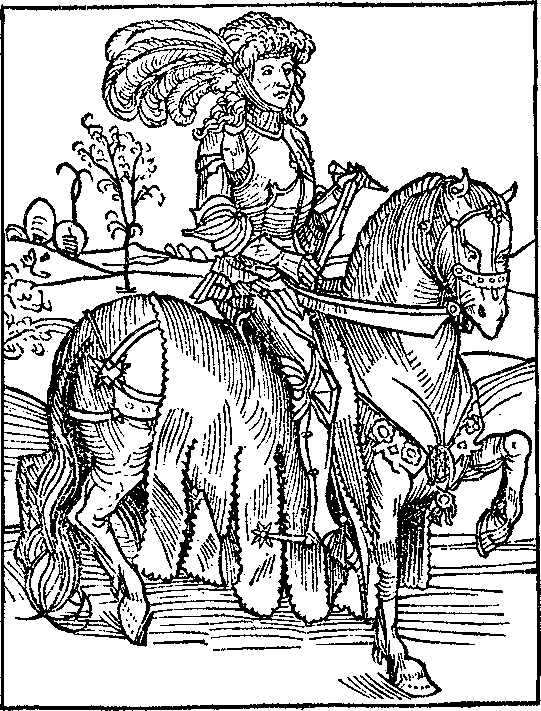
Arms for the Kyle Family Society
The Kyle Family Society might, in the future, apply to the Lyon court for Arms. We would like the participation of members in choosing the design. Corporate bodies such as our Society can have a shield and a crest.
The following are very rough drafts of different ideas for shield designs (the colors and artwork can be modified later):
Three Candles with Lion Chief
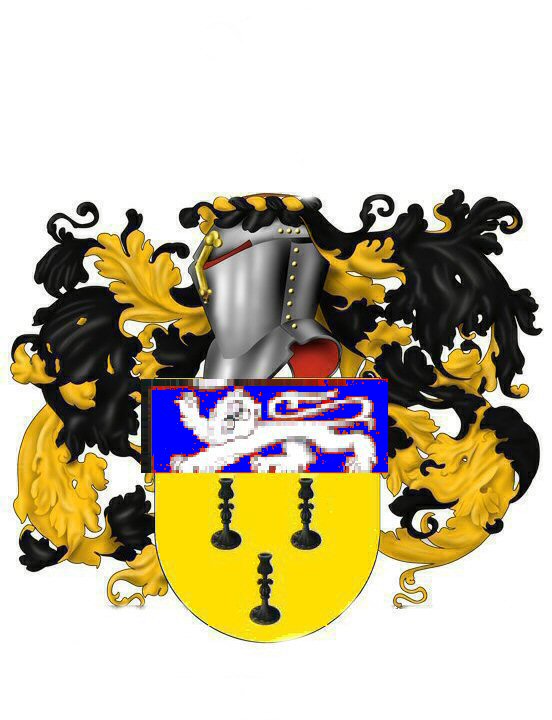
Three Candles with Stewart Checked Chief
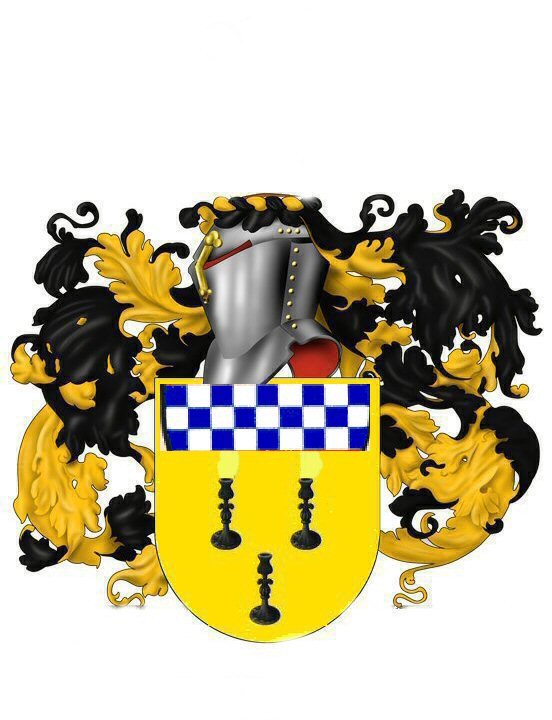
Three Candles with Welsh Dragon Chief
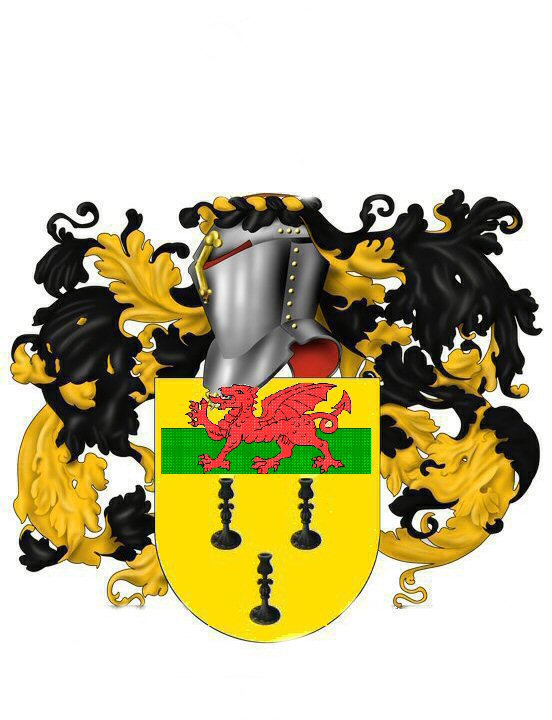
Three Candles with Gryphon Chief
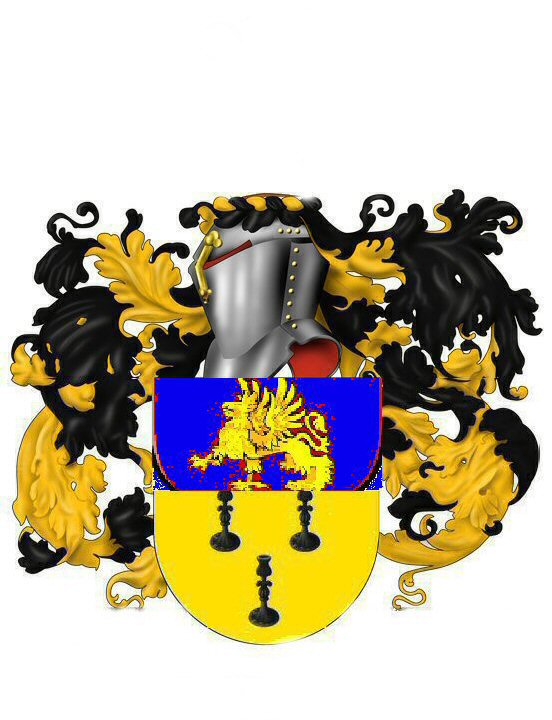
Meanings:
The Lion -- The Lion (red) is the royal banner of Scotland. The white lion is used by the MAcDowall Clan
The Checked pattern -- from the Stewart Arms. This checked pattern was also the arms for a Kyle district.
The Red Welsh Dragon --- the people living in Kyle at the time of Old King Cole spoke a P-Celtic Language closest to Welsh.
The Gryphon -- Old King Cole might have been Roman (the animal is half Roman Imperial Eagle) mixed with Scots (the Lion half)
Do you have other suggestions? email them to kylesociety@hotmail.com
Members, please vote as to which crest and which shield you prefer.
Click "Members Message Board," log on, then click the tab for "polls" on the left side.
The following are very rough drafts of different ideas for crest designs (the colors and the artwork can be modified later):
The Stag Crest The Arm and Scimitar The Cup and Pipe A Winged Lion with Chalice A Sun
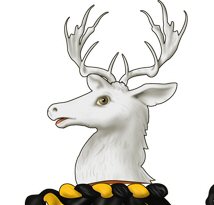

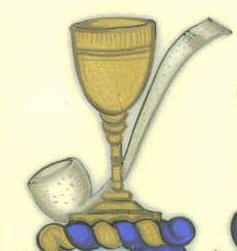
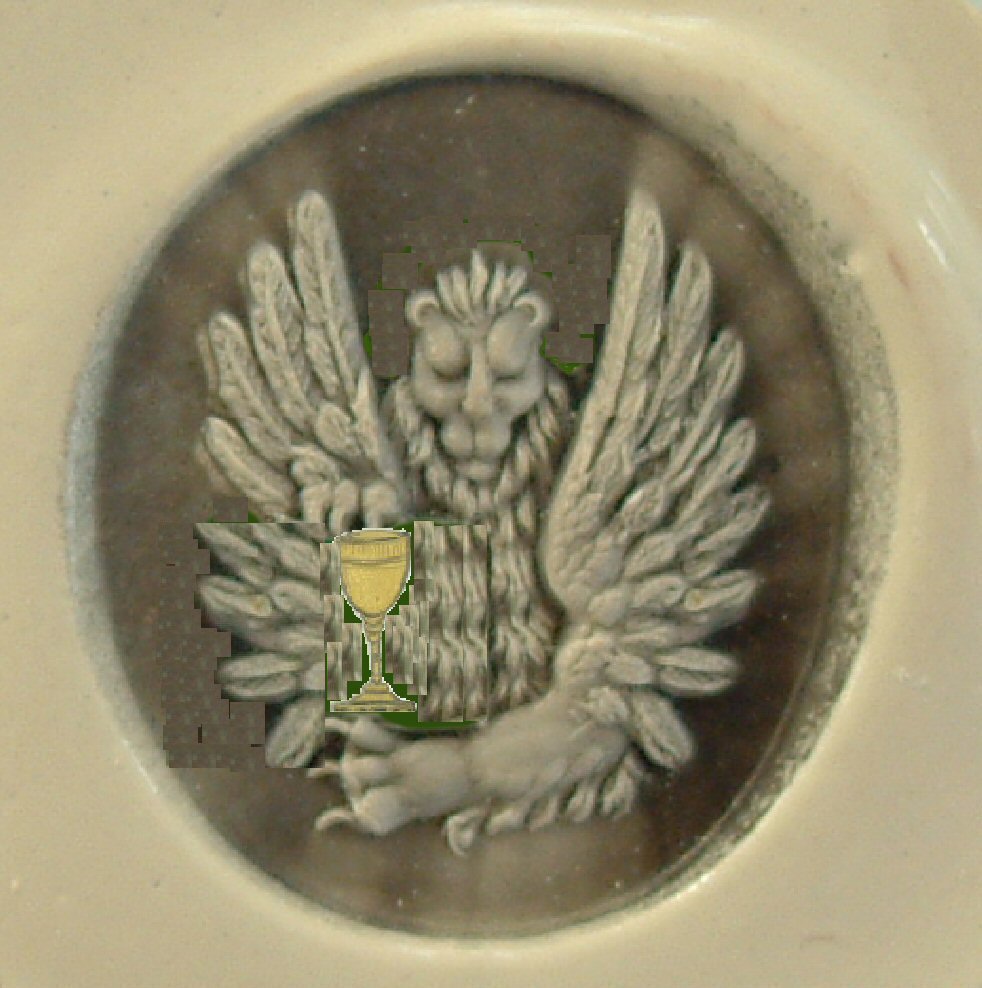

Meanings:
The Stag Head -- used on several old Kyle Arms. Stags sometime represent an animal that only fights in defense.
The Arm and Scimitar -- used on an several old Kyle Arms. Might be related to Wallace or some MacDougal Crests. Might refer to service in the crusades.
The Cup and Pipe -- a reference to Old King Cole.
The Winged Lion with Chalice -- the Lion refers to the Scots Royal Lion. The Wings to King Cole's Roman connection (Imperial Eagle of Rome). The Cup a reference to the nursery rhyme and to the Grail of King Arthur who was a descendant of King Cole
The Sun -- Old Welsh Genealogies trace King Cole's lineage back to Beli Mawr who is sometimes identified with an early sun god of ancient Britain.
Do you have other suggestions? email them to kylesociety@hotmail.com
Members, please vote as to which crest and which shield you prefer.
Click "Members Message Board," log on, then click the tab for "polls" on the left side.
